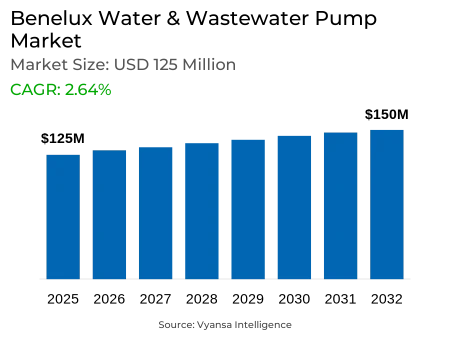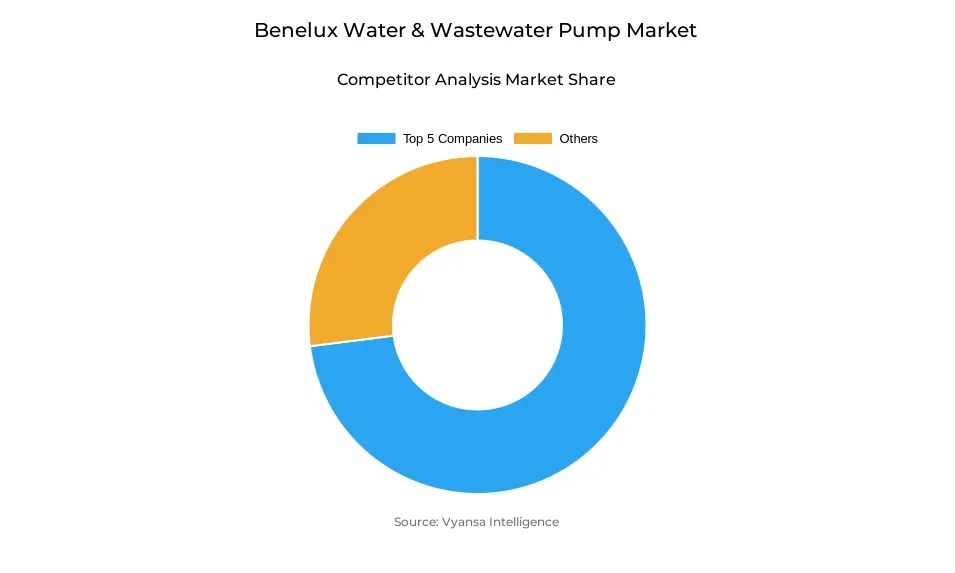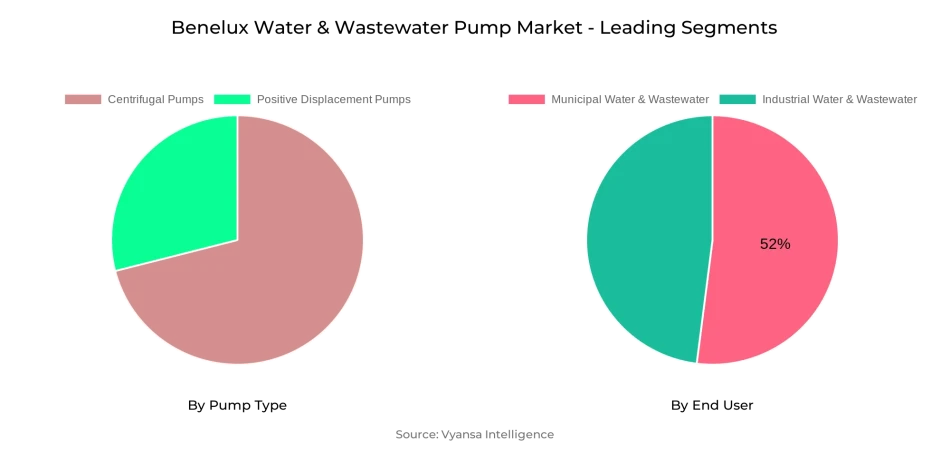Benelux Water & Wastewater Pump Market Report: Trends, Growth and Forecast (2026-2032)
By Pump Type (Centrifugal Pumps (End Suction, Split Case, Vertical (Turbine, Axial Pump, Mixed Flow Pump), Submersible Pump), Positive Displacement Pumps (Progressing Cavity, Diaphragm, Gear Pump, Others)), By Application (Water, Wastewater), By End User (Industrial Water & Wastewater, Municipal Water & Wastewater)
- Energy & Power
- Dec 2025
- VI0473
- 115
-




Benelux Water & Wastewater Pump Market Statistics and Insights, 2026
- Market Size Statistics
- Water & Wastewater Pump in Benelux is estimated at $ 125 Million.
- The market size is expected to grow to $ 150 Million by 2032.
- Market to register a CAGR of around 2.64% during 2026-32.
- Pump Type Segment
- Centrifugal Pumps continues to dominate the market.
- Competition
- More than 10 companies are actively engaged in producing Water & Wastewater Pump in Benelux.
- Top 5 companies acquired the maximum share of the market.
- ITT, IDEX, Dover, Flowserve, Sulzer AG etc., are few of the top companies.
- End User
- Municipal Water & Wastewater grabbed 52% of the market.
Benelux Water & Wastewater Pump Market Outlook
The Benelux water and wastewater pump market is experiencing consistent growth, fueled by stringent enforcement of European water quality guidelines and increasing infrastructure investments. The Netherlands and Luxembourg realize rates of over 99%, and Belgium retains 95%, providing constant demand for up-to-date pumping solutions. Supported by initiatives like the European Investment Bank's €70 million loan to Oasen and Belgium's €155 million Blue Deal, the utilities are strengthening networks to enhance resilience, efficiency, and compliance with regulations. Market size valued at USD 125 million in 2025 is expected to grow to USD 150 million by 2032.
Energy consumption issues still persist, since pumps are amongst the most energy-consuming equipment at water treatment plants. Italian case studies emphasize how aerobic systems utilize over twice the energy of anaerobic ones, highlighting operating cost pressures in Europe. Belgium's water shortage of 80% available supply further boosts pump operation, particularly during climate-driven events such as the 2021 floods. Such factors compel utilities to find solutions that meet the optimum balance of efficiency, resilience, and affordability.
Adoption of technology is redesigning operations, with IoT-based monitoring, AI-backed SCADA systems, and digital twin solutions maximizing pump performance and minimizing downtime. Utilities like CILE in Liège already have over 250,000 connected devices, highlighting the role that smart water management plays in infrastructure reliability. EU initiatives like more than €650 million in Horizon 2020 funding help drive digitalization and reinforce possibilities for high-end pump suppliers.
Centrifugal pumps lead from a segment standpoint based on their reliability, cost-effectiveness, and capacity to serve large industrial and municipal applications. Municipal water and wastewater drive demand at 52%, indicating its key position in ensuring public services. The industrial users are the fastest-growing segment, growing through water reuse projects and sophisticated process demands. Combined, these trends put the Benelux market on track for steady and sustainable growth through 2032.

Benelux Water & Wastewater Pump Market Growth Driver
Regulatory Compliance Driving Infrastructure Upgrades
Benelux countries' water quality regulations are compelling utilities to upgrade their pumping equipment in response to demanding European directives. 99.59% wastewater treatment compliance is reported by the Netherlands, with Luxembourg at 99% and Belgium at 95% compliance levels, both of which surpass EU expectations. Although Belgium ranks 18th worldwide for water-stressed countries, it has maintained 95% sewage treatment compliance with EU laws. Such high rates of compliance stimulate persistent infrastructure spending, and thus persistent demand for effective pump technologies.
European Investment Bank provided €70 million to the 2022-2026 investment program of Dutch water utility company Oasen for improving water treatment capacity and climate resilience. Those kinds of investments throughout the region, such as €155 million in Belgium's Blue Deal, are fueling widespread upgrade of pump systems to stay in regulatory compliance and increase operational efficiency. This regulatory framework provides steady market demand for high-end pumping solutions.
Benelux Water & Wastewater Pump Market Challenge
Energy Efficiency Challenges Limiting Cost Optimization
Energy use is a significant operational issue at water treatment plants, with pumps responsible for large percentages of overall energy consumption. At Italian wastewater treatment plants, aerobic systems use on average 1.02 kWh/m³, more than twice the use of anaerobic systems at 0.43 kWh/m³. That energy usage equals significant operational expenses, with Italy's wastewater industry using some 3,250 GWh per year.
Aging infrastructure and climate change only add to these pressures, as Belgium suffers from water stress that impacts 80% of accessible water every year, leading utilities to run pumps more intensively. Energy-water nexus is especially challenging during severe weather conditions, like the 2021 floods in Belgium, which destroyed key infrastructure and raised operating requirements. These put continuous pressure on utilities to weigh energy expenses against service dependability, reducing their capability to optimize operating costs.
Benelux Water & Wastewater Pump Market Trend
Digital Transformation Revolutionizing System Management
Advanced water management technologies are revolutionizing the way pump systems work throughout the Benelux region. IoT sensors now make it possible to monitor real-time water flow, pressure, and quality parameters, with applications such as those implemented by CILE in Liège linking more than 250,000 IoT devices throughout their water network. These applications allow for automated leak and backflow alerts and optimize pump function according to actual demand patterns instead of predetermined schedules.
Emerging automation technologies are enhancing operational effectiveness by predictive maintenance and smart control systems. SCADA platforms are now complemented with AI-driven analytics to predict patterns of demand and adjust chemical dosing automatically. Digital twin technology enables utilities to model whole water networks, better planning for and responding to changing conditions. Such technological change is facilitated by massive EU investment, with more than €650 million in Horizon 2020 funding committed to digital innovations in water.
Benelux Water & Wastewater Pump Market Opportunity
Circular Economy Creating New Market Segments
The transition to circular water management is creating important growth prospects for niche pump applications. The EU Water Reuse Regulation 2020/741 sets a minimum level for treated urban wastewater reuse in agricultural irrigation, opening up new markets for reclaimed water system pumps. It's already above 90% and 60% in countries such as Cyprus and Malta, respectively, showing the scope for development in the region.
Decentralized water treatment technologies are becoming affordable options for rural communities and industrial processes, necessitating custom pump set-ups. The European Commission's Circular Economy Action Plan also covers legislative proposals for the reuse of wastewater, with estimated EU use of reclaimed water at 6.6 hm³, mainly focused on Mediterranean countries. This circular concept decreases pressure on fresh sources while generating new revenue for water reuse product specialists.
Benelux Water & Wastewater Pump Market Segmentation Analysis

By Pump Type
- Centrifugal Pumps
- Positive Displacement Pumps
Centrifugal Pump is the top market share among the Pump Type category, with continued leadership of the market scene. Centrifugal pumps remain in the top position due to their efficiency, reliability, and application to high-volume water and wastewater usage common in the Benelux area. Centrifugal pumps are superior in municipal water treatment plants, industrial processes, and irrigation systems that involve large volumes of water and moderate pressure requirements.
Their broad adoption is due to reduced maintenance needs over positive displacement options and improved cost-effectiveness for continuous running situations. Centrifugal pumps now leverage variable frequency drives and intelligent monitoring features to make them ever more appealing for new water management uses. The segment enjoys well-established supply networks, extensive servicing networks, and established performance credentials in applications within critical infrastructure in Belgium, Netherlands, and Luxembourg.
By End User
- Industrial Water & Wastewater
- Municipal Water & Wastewater
The Municipal Water & Wastewater segment holds the largest market share in the End User category with 52% market share. This is an indication of the critical role played by public water utilities and the large-scale infrastructure investments made in the Benelux region to keep old distribution lines and treatment plants in operation.
The Industrial Water & Wastewater segment is the fastest growing end user segment with a 4.03% CAGR. The growth is prompted by mounting regulatory pressure on industrial sites to adopt water reuse and recycling infrastructure, as well as growth in manufacturing operations within high-tech industries. Industrial customers need sophisticated pump solutions for process water management, cooling system, and wastewater treatment applications, which lead to the segment's rapid growth trend over classic municipal applications.
Top Companies in Benelux Water & Wastewater Pump Market
The top companies operating in the market include ITT, IDEX, Dover, Flowserve, Sulzer AG, KSB, Xylem, Grundfos, Ebara, SPX Flow, etc., are the top players operating in the Benelux Water & Wastewater Pump Market.
Frequently Asked Questions
Related Report
1. Market Segmentation
1.1. Research Scope
1.2. Research Methodology
1.3. Definitions and Assumptions
2. Executive Summary
3. Benelux Water & Wastewater Pump Market Policies, Regulations, and Standards
4. Benelux Water & Wastewater Pump Market Dynamics
4.1. Growth Factors
4.2. Challenges
4.3. Trends
4.4. Opportunities
5. Benelux Water & Wastewater Pump Market Statistics, 2022-2032F
5.1. Market Size & Growth Outlook
5.1.1.By Revenues in US$ Million
5.2. Market Segmentation & Growth Outlook
5.2.1.By Pump Type
5.2.1.1. Centrifugal Pumps- Market Insights and Forecast 2022-2032, USD Million
5.2.1.1.1. End Suction- Market Insights and Forecast 2022-2032, USD Million
5.2.1.1.2. Split Case- Market Insights and Forecast 2022-2032, USD Million
5.2.1.1.3. Vertical- Market Insights and Forecast 2022-2032, USD Million
5.2.1.1.3.1. Turbine- Market Insights and Forecast 2022-2032, USD Million
5.2.1.1.3.2. Axial Pump- Market Insights and Forecast 2022-2032, USD Million
5.2.1.1.3.3. Mixed Flow Pump- Market Insights and Forecast 2022-2032, USD Million
5.2.1.1.4. Submersible Pump- Market Insights and Forecast 2022-2032, USD Million
5.2.1.2. Positive Displacement Pumps- Market Insights and Forecast 2022-2032, USD Million
5.2.1.2.1. Progressing Cavity- Market Insights and Forecast 2022-2032, USD Million
5.2.1.2.2. Diaphragm- Market Insights and Forecast 2022-2032, USD Million
5.2.1.2.3. Gear Pump- Market Insights and Forecast 2022-2032, USD Million
5.2.1.2.4. Others- Market Insights and Forecast 2022-2032, USD Million
5.2.2.By Application
5.2.2.1. Water- Market Insights and Forecast 2022-2032, USD Million
5.2.2.2. Wastewater- Market Insights and Forecast 2022-2032, USD Million
5.2.3.By End User
5.2.3.1. Industrial Water & Wastewater- Market Insights and Forecast 2022-2032, USD Million
5.2.3.2. Municipal Water & Wastewater- Market Insights and Forecast 2022-2032, USD Million
5.2.4.By Competitors
5.2.4.1. Competition Characteristics
5.2.4.2. Market Share & Analysis
6. Benelux Centrifugal Water & Wastewater Pump Market Statistics, 2020-2030F
6.1. Market Size & Growth Outlook
6.1.1.By Revenues in US$ Million
6.2. Market Segmentation & Growth Outlook
6.2.1.By Pump Type- Market Insights and Forecast 2022-2032, USD Million
6.2.2.By Application- Market Insights and Forecast 2022-2032, USD Million
6.2.3.By End User- Market Insights and Forecast 2022-2032, USD Million
7. Benelux Positive Displacement Water & Wastewater Pump Market Statistics, 2020-2030F
7.1. Market Size & Growth Outlook
7.1.1.By Revenues in US$ Million
7.2. Market Segmentation & Growth Outlook
7.2.1.By Pump Type- Market Insights and Forecast 2022-2032, USD Million
7.2.2.By Application- Market Insights and Forecast 2022-2032, USD Million
7.2.3.By End User- Market Insights and Forecast 2022-2032, USD Million
8. Competitive Outlook
8.1. Company Profiles
8.1.1.Flowserve Corporation
8.1.1.1. Business Description
8.1.1.2. Product Portfolio
8.1.1.3. Collaborations & Alliances
8.1.1.4. Recent Developments
8.1.1.5. Financial Details
8.1.1.6. Others
8.1.2.Ebara Corporation
8.1.2.1. Business Description
8.1.2.2. Product Portfolio
8.1.2.3. Collaborations & Alliances
8.1.2.4. Recent Developments
8.1.2.5. Financial Details
8.1.2.6. Others
8.1.3.WILO SE
8.1.3.1. Business Description
8.1.3.2. Product Portfolio
8.1.3.3. Collaborations & Alliances
8.1.3.4. Recent Developments
8.1.3.5. Financial Details
8.1.3.6. Others
8.1.4.Sulzer Limited
8.1.4.1. Business Description
8.1.4.2. Product Portfolio
8.1.4.3. Collaborations & Alliances
8.1.4.4. Recent Developments
8.1.4.5. Financial Details
8.1.4.6. Others
8.1.5.Grundfos Holding A/S
8.1.5.1. Business Description
8.1.5.2. Product Portfolio
8.1.5.3. Collaborations & Alliances
8.1.5.4. Recent Developments
8.1.5.5. Financial Details
8.1.5.6. Others
8.1.6.Xylem Inc.
8.1.6.1. Business Description
8.1.6.2. Product Portfolio
8.1.6.3. Collaborations & Alliances
8.1.6.4. Recent Developments
8.1.6.5. Financial Details
8.1.6.6. Others
8.1.7.KSB SE & Co. KGaA
8.1.7.1. Business Description
8.1.7.2. Product Portfolio
8.1.7.3. Collaborations & Alliances
8.1.7.4. Recent Developments
8.1.7.5. Financial Details
8.1.7.6. Others
8.1.8.Kirloskar Brothers Limited (KBL)
8.1.8.1. Business Description
8.1.8.2. Product Portfolio
8.1.8.3. Collaborations & Alliances
8.1.8.4. Recent Developments
8.1.8.5. Financial Details
8.1.8.6. Others
8.1.9.Franklin Electric
8.1.9.1. Business Description
8.1.9.2. Product Portfolio
8.1.9.3. Collaborations & Alliances
8.1.9.4. Recent Developments
8.1.9.5. Financial Details
8.1.9.6. Others
8.1.10. Pentair PLC
8.1.10.1. Business Description
8.1.10.2. Product Portfolio
8.1.10.3. Collaborations & Alliances
8.1.10.4. Recent Developments
8.1.10.5. Financial Details
8.1.10.6. Others
9. Disclaimer
| Segment | Sub-Segment |
|---|---|
| By Pump Type |
|
| By Application |
|
| By End User |
|
Research Methodology
This study followed a structured approach comprising four key phases to assess the size and scope of the electro-oxidation market. The process began with thorough secondary research to collect data on the target market, related markets, and broader industry context. These findings, along with preliminary assumptions and estimates, were then validated through extensive primary research involving industry experts from across the value chain. To calculate the overall market size, both top-down and bottom-up methodologies were employed. Finally, market segmentation and data triangulation techniques were applied to refine and validate segment-level estimations.
Secondary Research
The secondary research phase involved gathering data from a wide range of credible and published sources. This step helped in identifying industry trends, defining market segmentation, and understanding the market landscape and value chain.
Sources consulted during this phase included:
- Company annual reports, investor presentations, and press releases
- Industry white papers and certified publications
- Trade directories and market-recognized databases
- Articles from authoritative authors and reputable journals
- Gold and silver standard websites
Secondary research was critical in mapping out the industry's value chain and monetary flow, identifying key market segments, understanding regional variations, and tracking significant industry developments.
Other key sources:
- Financial disclosures
- Industry associations and trade bodies
- News outlets and business magazines
- Academic journals and research studies
- Paid industry databases
Primary Research
To validate secondary data and gain deeper market insights, primary research was conducted with key stakeholders across both the supply and demand sides of the market.
On the demand side, participants included decision-makers and influencers from end-user industries—such as CIOs, CTOs, and CSOs—who provided first-hand perspectives on market needs, product usage, and future expectations.
On the supply side, interviews were conducted with manufacturers, industry associations, and institutional participants to gather insights into current offerings, product pipelines, and market challenges.
Primary interviews provided critical inputs such as:
- Market size and revenue data
- Product and service breakdowns
- Market forecasts
- Regional and application-specific trends
Stakeholders consulted included:
- Leading OEM and solution providers
- Channel and distribution partners
- End users across various applications
- Independent consultants and industry specialists
Market Size Estimation and Data Triangulation
- Identifying Key Market Participants (Secondary Research)
- Goal: To identify the major players or companies in the target market. This typically involves using publicly available data sources such as industry reports, market research publications, and financial statements of companies.
- Tools: Reports from firms like Gartner, Forrester, Euromonitor, Statista, IBISWorld, and others. Public financial statements, news articles, and press releases from top market players.
- Extracting Earnings of Key Market Participants
- Goal: To estimate the earnings generated from the product or service being analyzed. This step helps in understanding the revenue potential of each market player in a specific geography.
- Methods: Earnings data can be gathered from:
- Publicly available financial reports (for listed companies).
- Interviews and primary data sources from professionals, such as Directors, VPs, SVPs, etc. This is especially useful for understanding more nuanced, internal data that isn't publicly disclosed.
- Annual reports and investor presentations of key players.
- Data Collation and Development of a Relevant Data Model
- Goal: To collate inputs from both primary and secondary sources into a structured, data-driven model for market estimation. This model will incorporate key market KPIs and any independent variables relevant to the market.
- Key KPIs: These could include:
- Market size, growth rate, and demand drivers.
- Industry-specific metrics like market share, average revenue per customer (ARPC), or average deal size.
- External variables, such as economic growth rates, inflation rates, or commodity prices, that could affect the market.
- Data Modeling: Based on this data, the market forecasts are developed for the next 5 years. A combination of trend analysis, scenario modeling, and statistical regression might be used to generate projections.
- Scenario Analysis
- Goal: To test different assumptions and validate how sensitive the market is to changes in key variables (e.g., market demand, regulatory changes, technological disruptions).
- Types of Scenarios:
- Base Case: Based on current assumptions and historical data.
- Best-Case Scenario: Assuming favorable market conditions, regulatory environments, and technological advancements.
- Worst-Case Scenario: Accounting for adverse factors, such as economic downturns, stricter regulations, or unexpected disruptions.
Partnering With Industry Leaders to Drive Growth
Our mission is to deliver intelligence that matters. By combining data, analysis, and industry expertise, we enable organizations to make smarter, faster, and more impactful decisions. Whether it’s a Fortune 500 company or a high-growth startup, businesses trust us to provide clarity in an ever-evolving marketplace.






